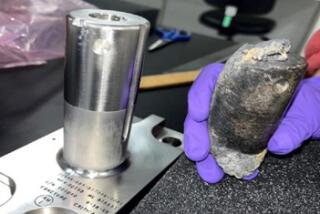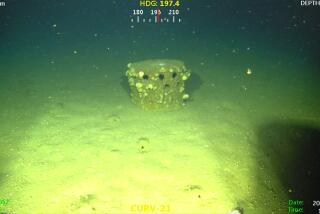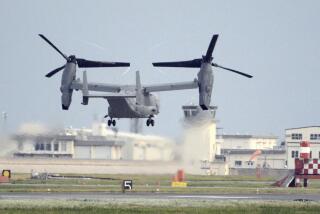Rocket Experts to View Photos of Debris
KENNEDY SPACE CENTER, Fla. â Photographs of underwater debris believed to be part of the space shuttle Challengerâs right solid rocket booster were flown to Huntsville, Ala., Monday to be examined by rocketry experts.
Engineers at the Marshall Space Flight Center there, which oversees construction of the boosters, will be able to determine whether the debris is that of the rocket suspected of causing the explosion that destroyed Challenger, killing all seven crew members, on Jan. 28.
Other officials of the National Aeronautics and Space Administration are examining small pieces of the debris picked up by a small, deep-diving submarine Saturday in 1,200 feet of water 40 miles east of Cape Canaveral.
âThe pieces that they picked up are not immediately identifiable as being part of an SRB (solid rocket booster),â NASA spokesman Hugh Harris said. As a result, it probably will be at least Wednesday before a positive identification is made, he said.
The discovery could provide the most important clue to date in the effort to identify a cause for the explosion.
Photographs of the launch show a puff of black smoke and, later, a plume of fiery gases emanating from the right booster 58 seconds after liftoff.
It is possible that through photographs of the debris the experts will be able to locate the source of any leak in the booster, making it unnecessary to retrieve the pieces from the deep ocean waters, Harris said.
Difficult Retrieval
âItâs very deep water and thereâs a significant current there, so itâs going to be difficult to retrieve them,â he said.
Meanwhile, a rocket expert called in by NASA six days after the Challenger explosion said Monday that NASA scientists knew at the time he was called what caused the disaster.
âMy opinion is (that) the scientific people I talked to knew exactly what happened, and getting it approved through their superiors is whatâs taking so long,â said Henry Shuey, a military consultant for 40 years who is considered one of the nationâs leading authorities on solid rocket motors.
Shuey said he was called by NASA as a consultant Feb. 3. âThey laid out all the data for me, and it made perfect sense,â Shuey said.
While Shuey said he could not be specific about the cause, the basic problem was âclearly an aft segment joint leak (in the right booster rocket). It sealed up and leaked again.â
When asked if the 38-degree weather on launch day might have caused the synthetic rubber seals in the rocket joints to fail, Shuey said: âI canât talk about that. Itâs a sensitive area.â
Production specifications on the seals have certified them at temperatures down to 40 degrees below zero. Shuey said military rockets have been safely launched at 60 degrees below zero.
âBut it depends on what they (the seals) are designed for,â he said. âUsually a material thatâs designed for minus-40, it doesnât work as well at plus-60.â
NASA scientists identified the problem quickly because there are only a certain number of things that can go wrong with a solid-fuel rocket, Shuey said. âWhen you see the puff of black smoke coming out, you know where your problem is,â he said.
More to Read
Sign up for Essential California
The most important California stories and recommendations in your inbox every morning.
You may occasionally receive promotional content from the Los Angeles Times.










